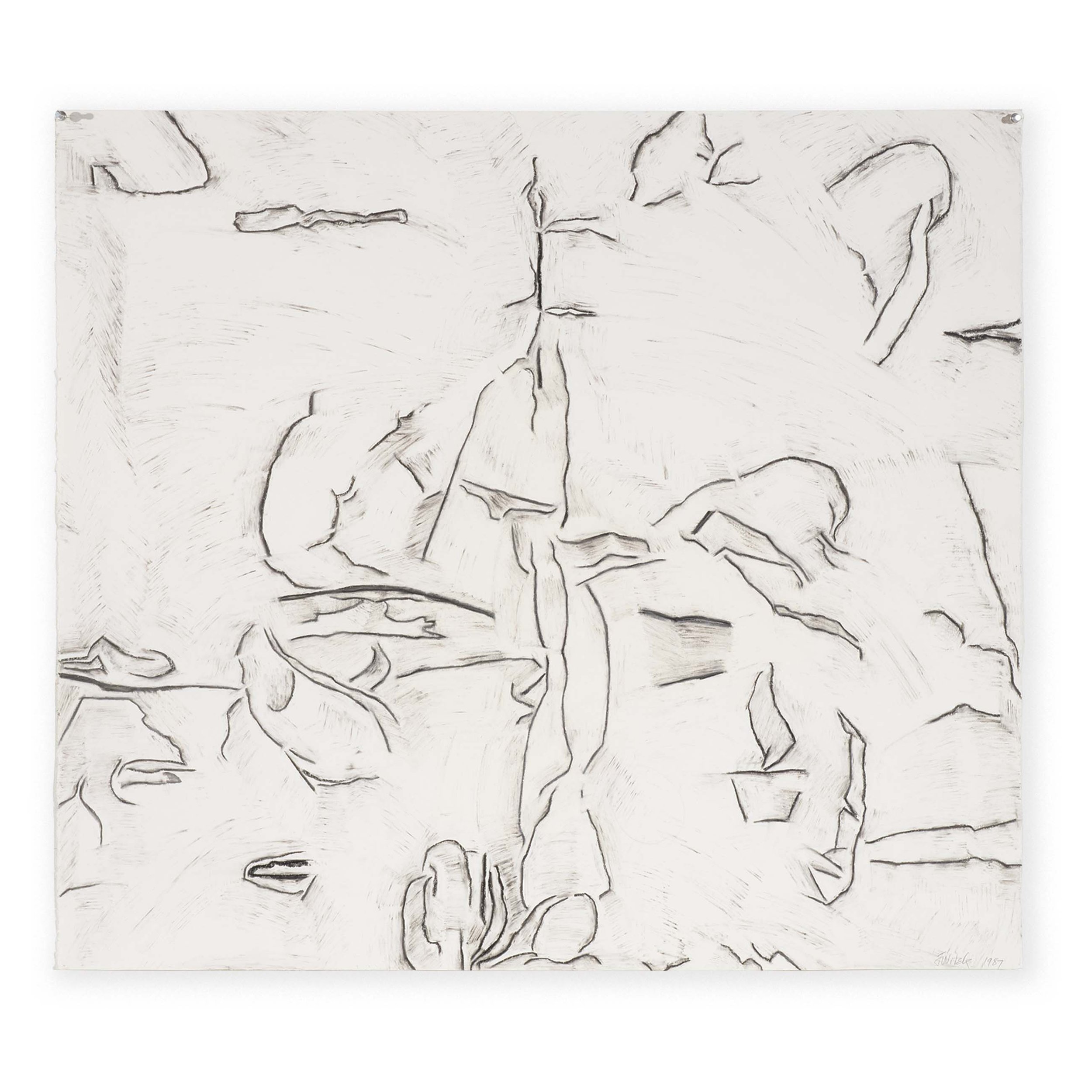D-141, 1997 Ink and graphite on paper Frame Size: 34 x 26.5 (86.4 x 67.3 x 3.8 cm) Signed lower right: "J Witek 1999"; Label Verso: Rosa Esman, NY Collection of the artist
| “ | Why black? Because it's the color of language. |
The late 80s into the 90s mark a polarization of Witek’s vision, the binary element intrinsic in her earlier paintings expands and develops into two clearly defined avenues of enquiry - one a lighter more organic line on lighter ground, the other a darker almost entirely black palette, wherein rectilinear forms are placed, which she titles the Bunker series.
Michael Kimmelman in The New York Times reviews her lighter works as "evok[ing] something wonderfully lyrical and quietly pleasing.”* In reversing the coloration and using a white ground, the glyphs become less ordered and are dissolved into an organic free form, an undulating biomorphic space which explores the perspectival plane in a new way. A middle ground evolves and a more expansive imagery of the spaces in between develops. Witek is inspired by trips to Europe, the rich history of landscape painting and the experience of the Spanish landscape.
“[s]uggestive of landscape. Small sometimes wispy cloud like shapes hover over hilly terrain, while the flow of hatching in and around implied masses at times gives the impression of rivers…viewed close up, the repetitive marks in these works are brought into focus; at a distance, the overall pattern comes into view. […] This mode of seeing provides the link between Witek’s recent works and her earlier paintings. Just as the small glitches changed the appearance of a vast field of otherwise repetitive marks, so these areas of open black forms resolve into a multitude of small-scale marks.” David Carrier, Art in America, July 1987
The Bunker series origins can be traced back to the work titled Edward Teller’s Dream which she painted in 1982. At the time, this painting was unique in her oeuvre as it deliberately made use of the traditional association of black with death. Witek had been researching Egyptian tomb architecture, the burial iconography and architectural form serving as reference material for the compositional elements in the painting. In addition however, the piece was also her response to a 1982 New York Times interview with Edward Teller, who had been instrumental in the production of the first atomic bomb. By definition, a bunker is described as a reinforced underground shelter, typically for use in wartime, and by association, the minimal form of the works in this series carry more somber overtones. The raised maze-like relief detailed in many of the Bunker works is also reminiscent of the walls of hieroglyphs found in ancient Egyptian burial chambers.
Solo exhibitions include Joan Witek: Paintings and Drawings 1970s-1990s at Kendall Campus Art Gallery, Miami (’93), Joan Witek: Drawings at Wynn Kramarsky, New York (’97), Group Exhibitions include Drawings at Pamela Auchincloss Gallery, New York (’91), Towards a New Museum: Recent Acquisitions in the Department of Painting and Sculpture, 1985-1991, San Francisco Museum of Art, CA (’91), Slow Art: Painting in New York Now at P.S.1 Museum, NY (’92), Joan Witek / Maura Sheehan at Helen Cevern Gallery, NY (’93), Paper Under Pressure at the Ackland Art Museum, University of North Carolina, NC (’94), Recent Acquisitions at Kendall Campus Art Gallery, FL (’95), Basic Marks: Black & White Painting, curated by Michael Mulheron at Stephen Rosenberg Gallery, NY (’95), Partners in Printmaking: Works from SOLO Impression at the National Museum of Women in the Arts, Washington, D.C. (’96), World View at Rosenberg & Kaufman Fine Art, NY (’97), Painted Black at Broad Center, NY Law School, NY (’97), After the Fall: Aspects of Abstract Painting Since 1970, Newhouse Center for Contemporary Art, Staten Island (’97), The Whole World in a Small Painting, Trans-Hudson Gallery, NY (’97), Drawing Is Another Kind of Language: Recent American Drawings from a New York Private Collection, Harvard University Museums: Sackler, Cambridge, MA (’97), Paintings from the Permanent Collection, Kendall Campus Art Gallery, Miami, FL (’98), Garner Tullis: The Art of Collaboration curated by David Carrier, Associated Artists of Pittsburgh, PA (’98), Women and Geometric Abstraction curated by Kit White, Pratt, Manhattan & Schafler Galleries, Brooklyn, NY (’99), Die Kunst der Linie (The Art of the Line), Landesmuseum, Linz, Austria (’99), Waxing Poetic: Encaustic Art In America curated by Gail Stavitsky at Montclair Art Museum, Montclair, NJ - exhibition traveled to the Knoxville Art Museum, Knoxville, TN (’99)












